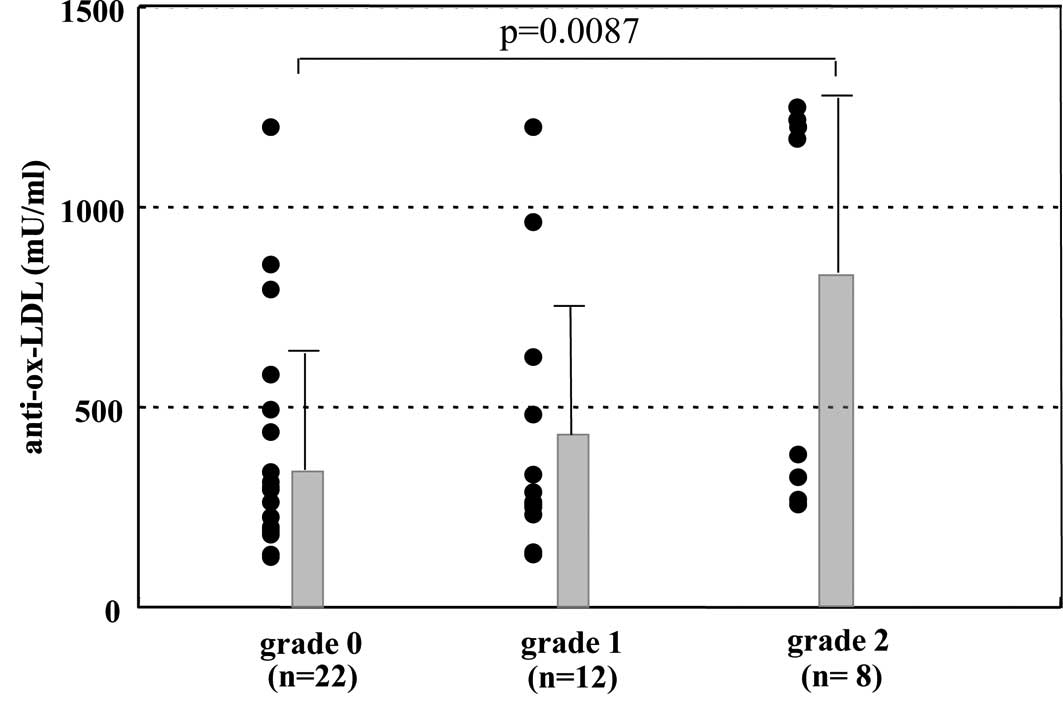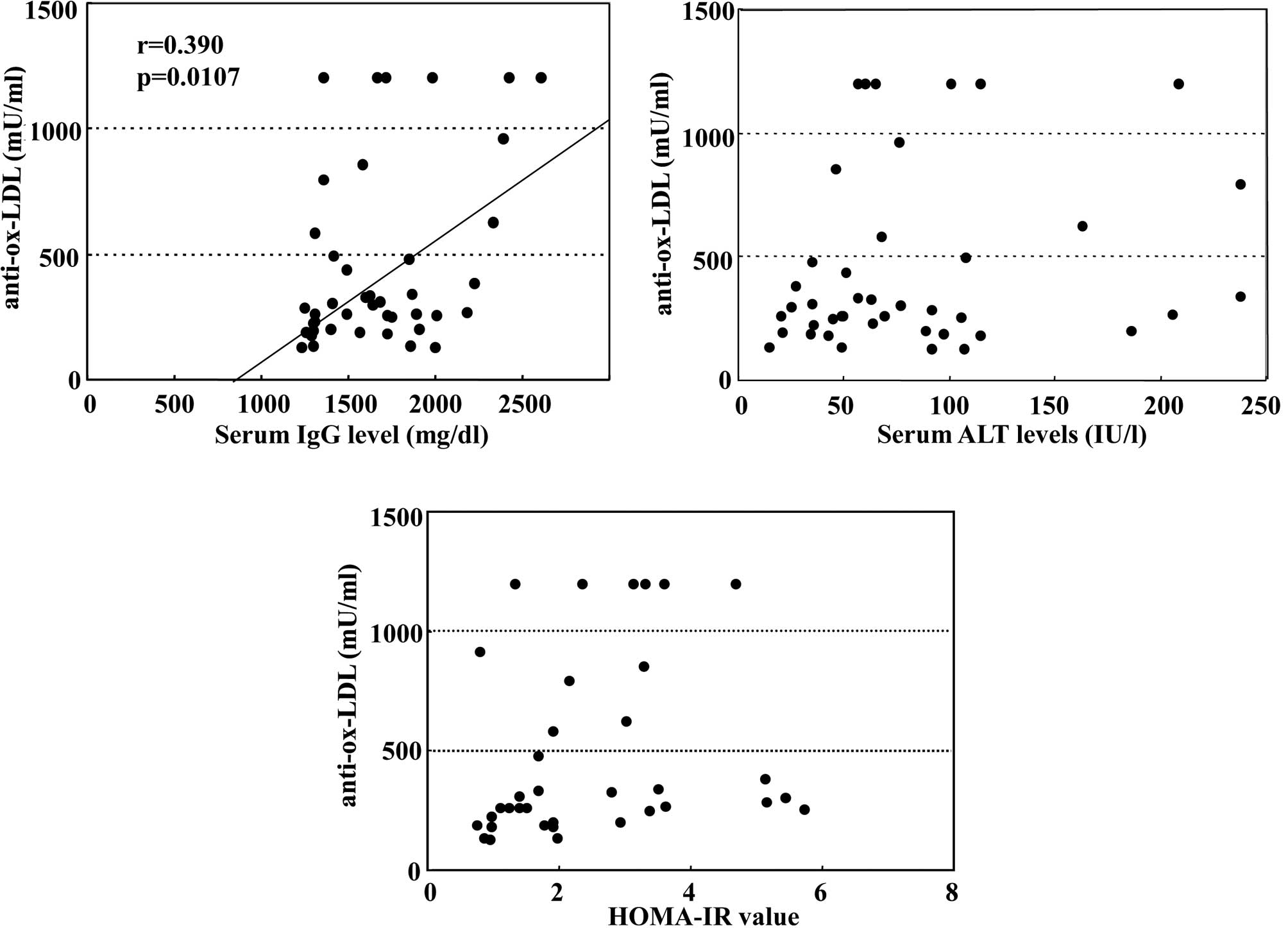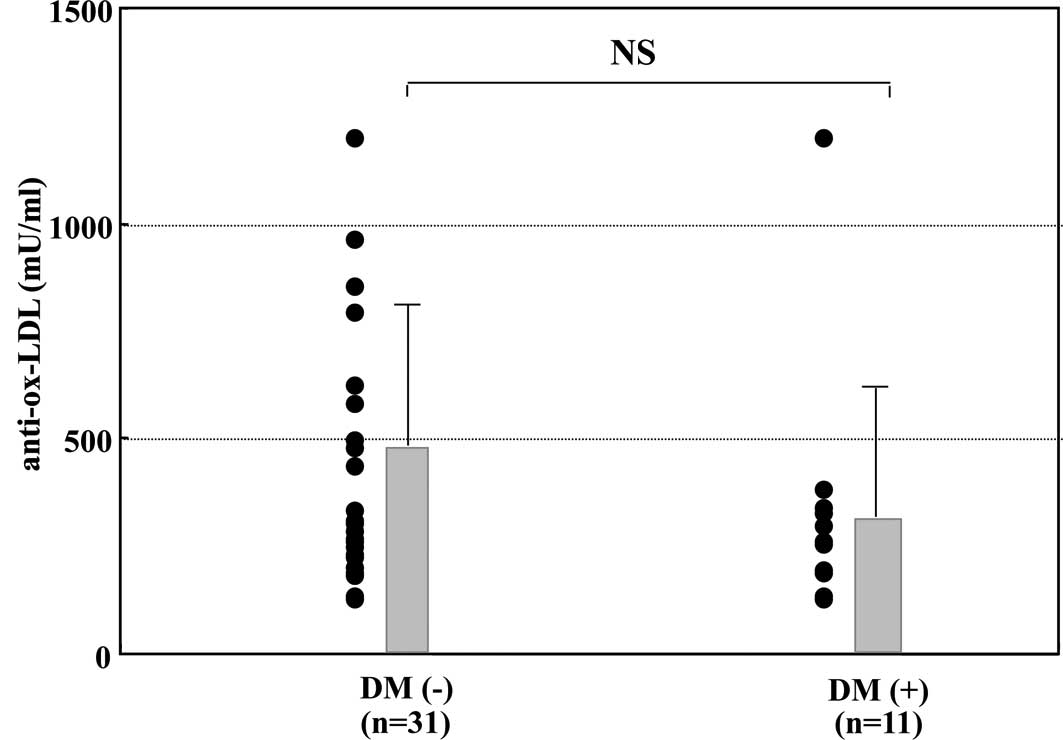|
1.
|
Koike K and Miyoshi H: Oxidative stress
and hepatitis C viral infection. Hepatol Res. 34:65–73. 2006.
View Article : Google Scholar : PubMed/NCBI
|
|
2.
|
Okuda M, Li K, Beard MR, et al:
Mitochondrial injury, oxidative stress, and antioxidant gene
expression are induced by hepatitis C virus core protein.
Gastroenterology. 122:366–375. 2002. View Article : Google Scholar : PubMed/NCBI
|
|
3.
|
Farinati F, Cardin R, De Maria N, et al:
Iron storage, lipid peroxidation and glutathione turn over in
chronic anti-HCV positive hepatitis. J Hepatol. 22:449–456. 1995.
View Article : Google Scholar : PubMed/NCBI
|
|
4.
|
Lonardo A, Adinolfi LE, Loria P, et al:
Steatosis and hepatitis C virus: mechanisms and significance for
hepatic and extrahepatic disease. Gastroenterology. 126:588–597.
2004. View Article : Google Scholar : PubMed/NCBI
|
|
5.
|
Moriya K, Yotsuyanagi H, Shintani Y, et
al: Hepatitis C virus core protein induces hepatic steatosis in
transgenic mice. J Gen Virol. 78:1527–1531. 1997.PubMed/NCBI
|
|
6.
|
Devenyi P, Rutherdale J, Sereny G and Olin
JS: Clinical diagnosis of alcoholic fatty liver. Am J
Gastroenterol. 54:597–602. 1970.PubMed/NCBI
|
|
7.
|
Murthy VK and Shipp JC: Hepatic steatosis
in diabetes: increased synthesis of triglycerol and impaired
feedback regulation. Trans Assoc Am Physicians. 94:322–332.
1981.PubMed/NCBI
|
|
8.
|
Hill RB and Rude JFP: Cortisone-induced
lipaemia and hepatic steatosis in the male rat. Nature.
210:7331966. View
Article : Google Scholar : PubMed/NCBI
|
|
9.
|
Hourigan LF, Macdonald GA, Purdie D, et
al: Fibrosis in chronic hepatitis C correlates significantly with
body mass index and steatosis. Hepatology. 29:1215–1219. 1999.
View Article : Google Scholar : PubMed/NCBI
|
|
10.
|
Adinolfi LE, Gambardella M, Andreana A,
Tripodi MF, Utili R and Ruggiero G: Steatosis accelerates the
progression of liver damage of chronic hepatitis C patients and
correlates with specific HCV genotype and visceral obesity.
Hepatology. 33:1358–1364. 2001. View Article : Google Scholar : PubMed/NCBI
|
|
11.
|
Monto A, Alonzo J, Watson JJ, Grunfeld C
and Wright TL: Steatosis in chronic hepatitis C: relative
contribution of obesity, diabetes mellitus, and alcohol.
Hepatology. 36:729–736. 2002. View Article : Google Scholar : PubMed/NCBI
|
|
12.
|
Hui JM, Kench J, Farrell GC, et al:
Genotype-specific mechanisms for hepatic steatosis in chronic
hepatitis C infection. J Gastroenterol Hepatol. 17:873–881. 2002.
View Article : Google Scholar : PubMed/NCBI
|
|
13.
|
Poynard T, Ratziu V, McHutchison J, et al:
Effect of treatment with peginterferon or interferon alfa-2b and
ribavirin on steatosis in patients infected with hepatitis C.
Hepatology. 38:75–85. 2003. View Article : Google Scholar : PubMed/NCBI
|
|
14.
|
Fartoux L, Poujol-Robert A, Guechot J,
Wendum D, Poupon R and Serfaty L: Insulin resistance is a cause of
steatosis and fibrosis progression in chronic hepatitis C. Gut.
54:1003–1008. 2005. View Article : Google Scholar : PubMed/NCBI
|
|
15.
|
Camma C, Bruno S, Marco VD, et al: Insulin
resistance is associated with steatosis in nondiabetic patients
with genotype 1 chronic hepatitis C. Hepatology. 43:64–71. 2006.
View Article : Google Scholar : PubMed/NCBI
|
|
16.
|
Soresi M, Tripi S, Franco V, et al: Impact
of liver steatosis on the antiviral response in hepatitis C
virus-associated chronic hepatitis. Liver Int. 26:1119–1125. 2006.
View Article : Google Scholar : PubMed/NCBI
|
|
17.
|
Westin J, Lagging M, Dhillon AP, et al:
Impact of hepatic steatosis on viral kinetics and treatment outcome
during antiviral treatment of chronic HCV infection. J Viral Hepat.
14:29–35. 2007. View Article : Google Scholar : PubMed/NCBI
|
|
18.
|
Ohta K, Hamasaki K, Toriyama K, et al:
Hepatic steatosis is a risk factor for hepatocellular carcinoma in
patients with chronic hepatitis C virus infection. Cancer.
97:3036–3043. 2003. View Article : Google Scholar : PubMed/NCBI
|
|
19.
|
Kumar D, Farrell GC, Kench J and George J:
Hepatic steatosis and the risk of hepatocellular carcinoma in
chronic hepatitis C. J Gastroenterol Hepatol. 20:1395–1400. 2005.
View Article : Google Scholar : PubMed/NCBI
|
|
20.
|
Pawlotsky JM, Yahia MB, Andre C, et al:
Immunological disorders in C virus chronic active hepatitis: a
prospective case-control study. Hepatology. 19:841–848. 1994.
View Article : Google Scholar : PubMed/NCBI
|
|
21.
|
Manns MP and Rambusch EG: Autoimmunity and
extrahepatic manifestations in hepatitis C virus infection. J
Hepatol. 31:S39–S42. 1999. View Article : Google Scholar : PubMed/NCBI
|
|
22.
|
Vaarala O, Alfthan G, Jauhiainen M, et al:
Crossreaction between antibodies to oxidized low-density
lipoprotein and to cardiolipin in systemic lupus erythematosus.
Lancet. 341:923–925. 1993. View Article : Google Scholar : PubMed/NCBI
|
|
23.
|
Hsu RM, Devaraj S and Jialal I:
Autoantibodies to oxidized low-density lipoprotein in patients with
type 2 diabetes mellitus. Clin Chim Acta. 317:145–150. 2002.
View Article : Google Scholar : PubMed/NCBI
|
|
24.
|
Lau JY, Davis GL, Kinffen J, et al:
Significance of serum hepatitis C virus RNA levels in chronic
hepatitis C. Lancet. 341:1501–1504. 1993. View Article : Google Scholar : PubMed/NCBI
|
|
25.
|
Simmonds P, Alberti A, Alter HJ, et al: A
proposed system for nomenclature of hepatitis C viral genotypes.
Hepatology. 19:1321–1324. 1994. View Article : Google Scholar : PubMed/NCBI
|
|
26.
|
Brunt EM, Janney CG and Bisceglie D:
Nonalcoholic steatohepatitis: a proposal for grading and staging
the histological lesions. Am J Gastroenterol. 94:2467–2474. 1999.
View Article : Google Scholar : PubMed/NCBI
|
|
27.
|
Ichida F, Tsuji T, Omata M, et al: New
Inuyama classification: new criteria for histological assessment of
chronic hepatitis. Int Hepatol Commun. 6:112–119. 1996. View Article : Google Scholar
|
|
28.
|
Knodel RG, Ishak KG, Black WC, et al:
Formulation and application of a numerical scoring system for
assessing histological activity in asymptomatic chronic active
hepatitis. Hepatology. 1:431–435. 1981. View Article : Google Scholar
|
|
29.
|
Becarevic M, Singh S and Majkic-Singh N:
Oxidized LDL, anti-oxidized LDL and anti-annexin A5 antibodies in
primary antiphospholipid syndrome. Clin Lab. 54:97–101.
2008.PubMed/NCBI
|
|
30.
|
Shoji T, Nishizawa Y, Fukumoto M, et al:
Inverse relationship between circulating oxidized low-density
lipoprotein (oxLDL) and anti-oxLDL antibody levels in healthy
subjects. Atherosclerosis. 148:171–177. 2000. View Article : Google Scholar : PubMed/NCBI
|
|
31.
|
Vidali M, Tripodi MF, Ivaldi A, et al:
Interplay between oxidative stress and hepatic steatosis in the
progression of chronic hepatitis C. J Hepatol. 48:399–406. 2008.
View Article : Google Scholar : PubMed/NCBI
|
|
32.
|
Loria P, Lonardo A, Leonardi F, et al:
Non-organ-specific autoantibodies in nonalcoholic fatty liver
disease: prevalence and correlates. Dig Dis Sci. 48:2173–2181.
2003. View Article : Google Scholar : PubMed/NCBI
|
|
33.
|
Adams LA, Lindo KD and Angulo P: The
prevalence of autoantibodies and autoimmune hepatitis in patients
with nonalcoholic fatty liver disease. Am J Gastroenterol.
99:1316–1320. 2004. View Article : Google Scholar
|
|
34.
|
Czaja AJ, Carpenter HA, Santrach PJ and
Moore SB: Host- and disease-specific factors affecting steatosis in
chronic hepatitis C. J Hepatol. 29:198–206. 1998. View Article : Google Scholar : PubMed/NCBI
|
|
35.
|
Escarcega RO, Garcia-Carrasco M,
Fuentes-Alexandro S, et al: Insulin resistance, chronic
inflammatory state and the link with systemic lupus
erythematosus-related coronary disease. Autoimmun Rev. 6:48–53.
2006. View Article : Google Scholar
|
|
36.
|
Gatselis NK, Georgiadou SP, Koukoulis GK,
et al: Clinical significance of organ- and non-organ-specific
autoantibodies on the response to anti-viral treatment of patients
with chronic hepatitis C. Aliment Pharmacol Ther. 24:1563–1573.
2006. View Article : Google Scholar : PubMed/NCBI
|
|
37.
|
Wasmuth HE, Stolte C, Geier A, et al: The
presence of non-organ-specific autoantibodies is associated with a
negative response to combination therapy with interferon and
ribavirin for chronic hepatitis C. BMC Infect Dis. 4:1–8. 2004.
View Article : Google Scholar : PubMed/NCBI
|

















